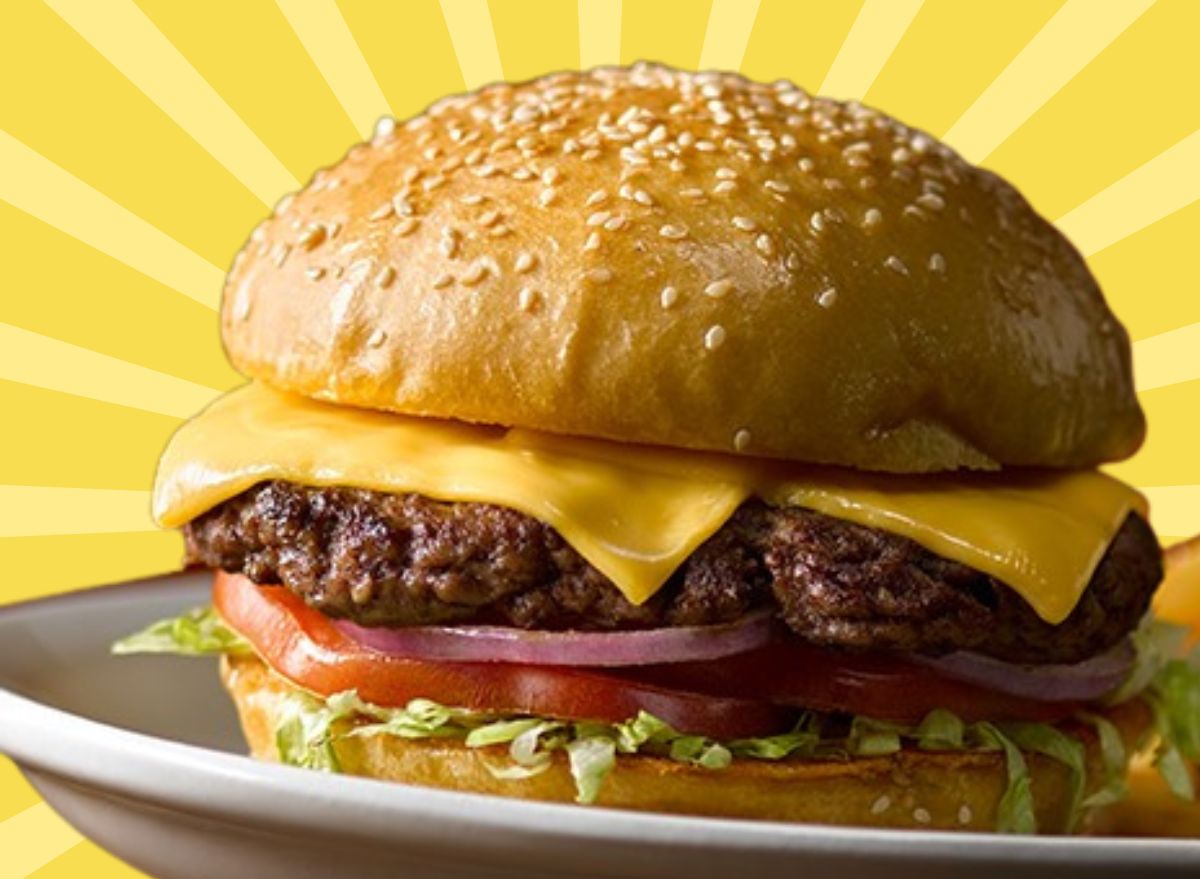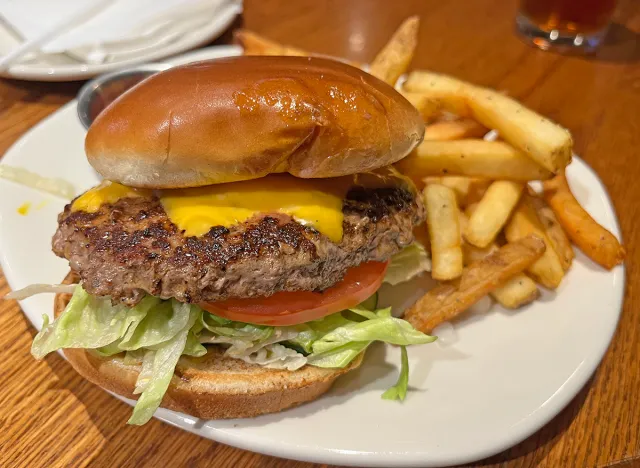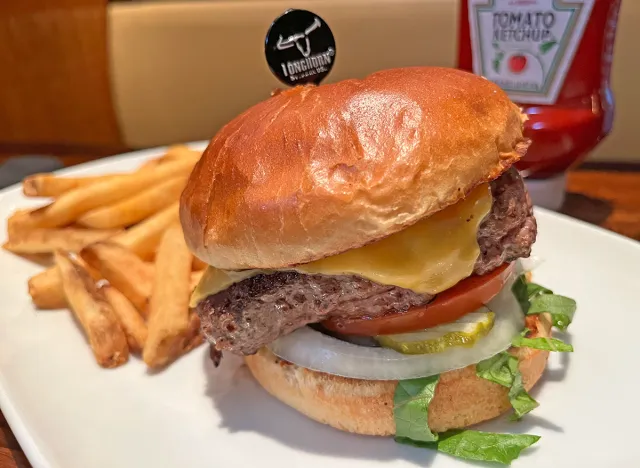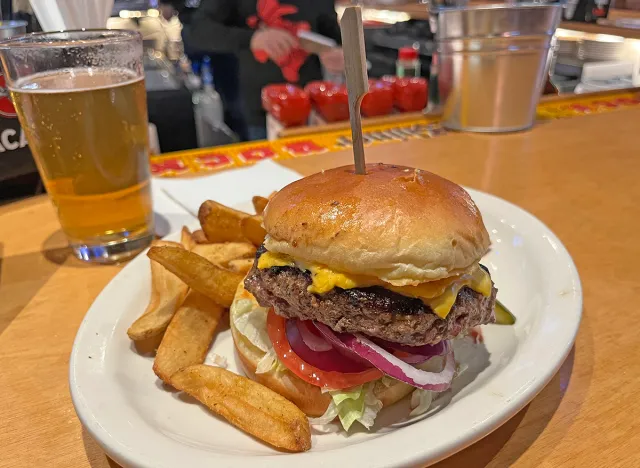I Tried the Burger at Outback, LongHorn & Texas Roadhouse and One Blew the Others Away

It's safe to say that most folks don't go to a steakhouse to eat salad. They go for the high-quality meats. Usually, that means a desirable cut of beef, like tender filet mignon or juicy bone-in ribeye. But there's another, much more underrated option that you should seriously consider the next time you sit down for a meaty meal at one of these places. I'm talking about the burger.
It may seem counterintuitive, but a steakhouse is often the best place to grab a burger. A resourceful restaurant makes the most of what it has, and beef emporiums are inevitably left with trimmings from many different cuts of meat. Those rich, fatty scraps can be ground into patties. The result is often a higher-quality, better-tasting burger than what you'll get at your local fast-food joint.
Right now might be the best time to get your burger fix at a steakhouse. With rising prices at many fast-food chains, the difference in cost is minimal. In some cases, it might even be cheaper!
At my local Burger King in Brooklyn, N.Y., the basic Whopper meal with medium-sized fries and a soft drink currently costs $11.79. The nearest Outback Steakhouse, meanwhile, charges only $1.70 more for its cheeseburger with fries. And if your burger cravings hit around lunchtime, you can actually save $1.80 by skipping Burger King and ordering your burger and fries at LongHorn Steakhouse instead.
I recently sampled the burgers at America's three biggest steakhouse chains—Outback, LongHorn, and Texas Roadhouse—to see which one makes the best beef patty on a bun at the best possible price. To keep things equal, I ordered the most basic cheeseburger available from each chain, all topped with American cheese (if given the choice) and cooked medium rare, just the way I like it.
Here's how each burger ranked in descending order from my least favorite to the overall best.
Outback Steakhouse

The Outbacker Burger with American Cheese (Per 1 Order)
Calories: 1,110
Fat: 78 g (Saturated Fat: 32 g, Trans Fat: 3 g)
Sodium: 2,080 mg
Carbs: 62 g (Fiber: 4 g, Sugar: 13 g)
Protein: 39 g
Of all the steakhouse chains in America, Aussie-themed Outback is still the largest, even after closing several "underperforming" locations last year. Its bright red sign currently beckons diners to 674 restaurants coast to coast, the vast majority owned and operated by corporate parent Bloomin' Brands. The company is currently spending hundreds of millions of dollars on opening new locations and renovating many others, as it vies to keep pace with its top-selling rivals, LongHorn and Texas Roadhouse.
Best known for its deep-fried Bloomin' Onion appetizer, Outback offers a considerable selection of beefy menu options, including two types of burgers (one even comes topped with crispy petals from that famous onion).
The chain's basic Outbacker Burger set me back $13.49 in Brooklyn, N.Y.—the highest price paid for any burger in this survey. You can save 50 cents by ordering the same burger at lunchtime, but it won't come with cheese.
The look: Glossy! The buttery bun glistened under the dining room lights. The whole sandwich stood over three inches tall with the charred patty itself measuring about one-third of an inch thick. Draped rather scantily with melty American cheese, the beef came piled atop diced onions, mustard, shredded lettuce, a few mildly spicy pickles, and a solitary slice of tomato. Overall, it's a solid-looking construction, with all the "toppings" on the bottom to help prevent the bun from dissolving into a sappy mess.
The taste: Mellow and juicy. In my experience, Outback tends to be quite heavy handed when seasoning its steaks, often to a fault. This burger had the opposite problem. The patty came only lightly salted at best, allowing more of the natural flavor to shine through, though the overall effect was a bit bland. Yet, the meat was very soft and moist—a manager informed me the patty was a blend of equal parts sirloin, brisket, and ground chuck—and the modest amount of veggies added crunch and brightness without detracting from the principal protein in any way.
In general, I enjoyed the Outbacker more than the average fast-food burger, but its rivals were both bigger and cost me less, which is why I've ranked it dead last on this list.
LongHorn Steakhouse

Half-Pound Steakhouse Cheeseburger (Per 1 Order)
Calories: 850
Fat: 51 g (Saturated Fat: 15 g, Trans Fat: 2 g)
Sodium: 1,150 mg
Carbs: 45 g (Fiber: 3 g, Sugar: 5 g)
Protein: 48 g
Like many steakhouse chains, LongHorn has surged in popularity lately. Sales have increased every quarter dating back to 2021, according to parent company Darden Restaurants, which currently operates 577 LongHorn locations around the country.
LongHorn's burger has the unique distinction of being both the most expensive and most affordable of all three major chains, depending on when your order. The best time to get a burger at LongHorn is lunchtime. You get the same half-pound patty that's served at dinnertime for five bucks less. The only real difference is that the dinner burger comes topped with applewood-smoked bacon (at lunch, you pay extra if you want the added pork). Nevertheless, the lunch option is the cheapest burger deal currently offered by the three major chains.
I got mine with a side of fries for just $9.99 in Bayonne, N.J., an unbeatable bargain compared to the others.
The look: Remarkably similar to the Outback version, with a lustrous bun encasing the cheese-smothered beef and classic toppings underneath. The main difference was size. The LongHorn burger just looked bigger, particularly the patty, which indeed dwarfed the other, measuring almost a full inch thick. A few other notable differences: a full slice of white onion instead of tiny diced shards and a creamy sauce in place of mustard. LongHorn also stabbed its burger with a large black toothpick, emblazoned with the chain's steer-head logo, to hold everything in place.
The taste: Richly flavored and well balanced. Like the Outback burger, this patty came lightly seasoned but nicely cooked, striking a luscious pinkish red in the center. The bun was perfectly toasted, offering a crisp texture at the edges while still staying pillowy in the center. I struggled to discern much about LongHorn's "signature burger sauce," slightly administered on the bottom bun, apart from a light tang. The most prominent flavor, apart from the beef, was the massive raw onion. Its bright crunch and sweetness nicely complemented the savory meat. That oniony taste, plus the big size and low price of the burger as a whole, easily catapulted the LongHorn burger ahead of its Outback counterpart, but there's still one burger I liked even better.
Texas Roadhouse

All-American Cheeseburger (Per 1 Order)
Calories: 880
Fat: 55 g (Saturated Fat: 22 g)
Sodium: 1,970 mg
Carbs: 48 g (Fiber: 5 g, Sugar: 11 g)
Protein: 50 g
As popular as LongHorn has become, there's no denying which chain is the industry's rising superstar, both within the steakhouse category and casual dining at large. Fast-growing Texas Roadhouse continues to outdo itself in terms of sales and traffic—emerging as the most likely candidate to overtake Olive Garden as America's top-selling restaurant brand. The Kentucky-based company operated at least 583 eponymous restaurants at the end of 2023 and continues to open more locations every quarter.
In addition to 10 different types of steak, the Roadhouse menu also includes three styles of burgers, the most basic being the All-American Cheeseburger. I paid $12.49 for this classic construction, served with steak fries and a pickle spear, in Parlin, N.J.
The look: Picture perfect. As sparkling as Outback's burger but larger like LongHorn's, the Roadhouse burger commanded attention. One nearby diner, picking at his mushroom-smothered sirloin, exclaimed, "Look at that! Next time, I'm getting the burger."
The sandwich stood nearly four inches tall with a fluffy golden bun that gleamed like it was freshly brushed with butter and a saturated slab of cheesy, darkly seared beef, measuring about three-quarters of an inch thick. The tender meat struck an enticing, cherry-blossom pink in the center. Like the other burgers, the toppings all came on the bottom, with a slice of ruby red tomato that appeared fresher and juicier than the others. One none-too-subtle twist: the Roadhouse burger came with slices of red onion, not white.
The taste: Even better than it looked. Exceedingly succulent and better seasoned than either rival, the Roadhouse burger stood apart with its salty, smoky beef patty and uber-buttery bun. Its superior juiciness could be easily measured by napkin count. I used up at least three before the burger was done. My one quibble: the pungent red onion. I greatly preferred LongHorn's crisp white onion, which better balanced the fatty flavor of the beef.
Otherwise, the winner was clear. Much like its bone-in ribeye, the burger at Roadhouse is hands down the standard bearer in casual steakhouse fare.
Why Trust Eat This, Not That!?
Eat This, Not That! is committed to creating high-quality content that you can trust to be accurate, properly researched, routinely reviewed, and updated with the latest information. Our writers, editors, and medical and/or certified experts consider this to be an unwavering promise we make to our readers in the pursuit of delivering impactful and meaningful content.









